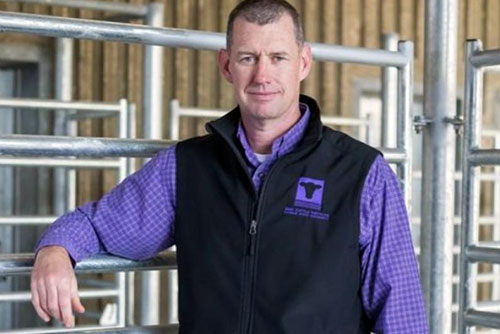September 30, 2024
Brad White obtains more than $2M in cumulative research funding to combat bovine respiratory disease

To identify and manage late day pulmonary disease in cattle, and to promote antimicrobial stewardship, the International Consortium for Antimicrobial Stewardship in Agriculture, or ICASA, awarded a $1,223,474 research grant led by Brad White, production medicine professor and director of the Beef Cattle Institute.
In addition to faculty from Kansas State University, the research team includes members from Colorado State University, Innovative Livestock Services, Five Rivers Cattle Feeding, Mississippi State University, Nanostring, Texas A&M University and Veterinary Research & Consulting Services. An additional $1,223,474 in matching funds was provided to all collaborators for a $2,446,948 total research investment.
Pulmonary or respiratory disease is the most common and costliest disease affecting beef cattle in North America. Bovine respiratory disease, commonly called “shipping fever,” occurs most frequently and is a multifactorial disease with multiple causes, including viruses, bacteria and environmental stressors. Interstitial pneumonia is another important respiratory disease that tends to occur later in the feeding phase. The goal of this project is to better understand respiratory diseases impacting cattle late in the feeding phase.
“Antibiotic resistance is a major global public health threat. Use of antibiotics over time results in bacteria becoming drug-resistant, and infections become difficult or impossible to treat,” said Jasmine Bruno, Foundation for Food & Agriculture Research scientific program director. “Dr. White’s research can lead to the mitigation of a prevalent secondary infection problem in feedlot cattle, which would reduce the need for antibiotics and help the beef industry use antibiotics more judiciously and reduce losses.”
Bovine respiratory disease costs ranchers in the United States about $900 million annually due to animal death, reduced feed efficiency and treatment costs. The disease is commonly treated with antibiotics to reduce these losses. Interstitial pneumonia also has important impacts on animal welfare and economic outcomes.
“The idea from this project was generated based on questions from producers related to late day pulmonary disease,” White said. “We formed a multidisciplinary team to better understand this disease to identify better methods for disease prevention, identification and control.”
The research aims to provide veterinarians and producers with the necessary information to make informed prevention and treatment decisions. Specifically, the team is creating a set of late day pulmonary disease uniform criteria, or surveillance case definitions, to enable stakeholders across geographies to classify and count cases consistently, which is a priority for the cattle industry. The team is assessing mortalities due to late day pulmonary disease in multiple geographic regions to generate data improving understanding of the disease process. The team is also employing late day pulmonary disease predictive analytics, or historical data, to forecast potential scenarios and identify high-risk cattle pens. Additionally, economic data collected as part of this grant will help determine optimal diagnostic intervention plans.
The research represents the most comprehensive assessment of risk factors and pathological characteristics of late day pulmonary disease ever reported, generating valuable results that will help ranchers and veterinarians improve animal welfare, mitigate the negative impacts of this disease and promoting antimicrobial stewardship.
